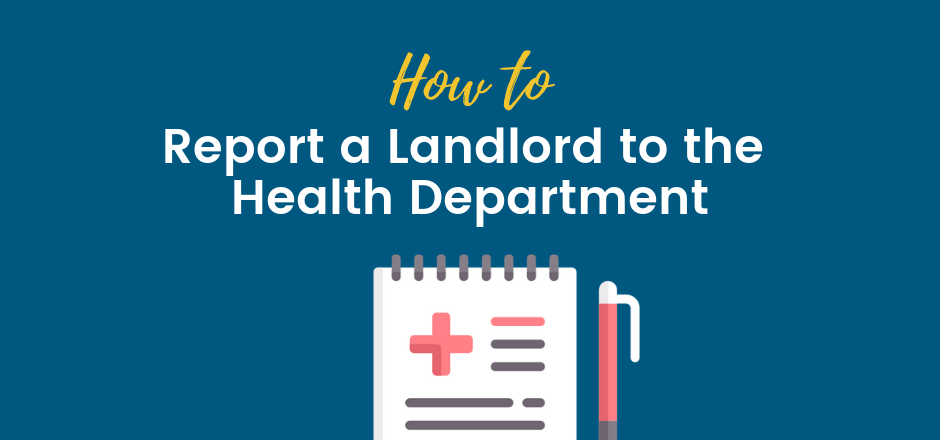How to Report a Landlord to the Health Department
If your landlord fails to address a complaint about an unsafe living condition, it might be time to file a report with the California Department of Public Health. Here’s how to report a landlord to the health department.

How to Report a Landlord to the Health Department
You’ve signed your lease, picked up your keys, and moved into your rental unit. Things were going great until you started to notice problems. Whether right away or in the months after moving in, your landlord is dragging his feet and isn’t making repairs. It’s making you concerned your home may become inhabitable.
As a tenant, you have rights in situations like these within the state of California. It may be time to report your landlord to the California Department of Public Health.
Here’s how to report a landlord to the health department…
Landlord Responsibilities
A landlord’s responsibilities regarding their property don’t end the second they turn the keys over to a new tenant. The rent you pay comes with expectations for a safe and secure home you can reasonably enjoy. This means your landlord is responsible for making sure your unit habitable and healthy to live in.
At a baseline level, the landlord’s responsibilities include ensuring you are safe within your own home. Windows and doors must work and lock properly, door locks must be changed between tenants, and you must be able to maintain “quiet enjoyment” of your property.
Landlords must also be responsible for making sure repairmen who enter your rental unit or property are licensed. If any work is done, they must ensure the work is up to code and gain the proper permits before it begins.
Property owners are also required to keep homes free of pests, like cockroaches or bedbugs. If an incident occurs, they have to offer treatment. Plumbing and electrical systems must be kept in good working order; you can’t be blamed for, say, a leaky pipe in a ceiling.
The landlord’s duty of maintenance does not stop at the interior; he or she must also keep stairs and sidewalks in good repair. And, while it doesn’t usually apply to most of southern California, they are responsible for snow removal, too.
While landlords are responsible for taking care of reasonable health and safety issues on the property, they are not responsible for remedying situations caused by the tenant. If you allow your kitchen to become dirty, or let dirty dishes and garbage pile up, it may attract pests. The landlord could make a reasonable case that you are responsible for remedying the issue because your failure of care caused the problem.
When to Report a Landlord
While some of your arrangements (such as utilities) are a part of your lease, others are not. Either way, your landlord still has an obligation to make sure all related systems are in functional order. If they don’t respond to your requests in a timely manner, you should file a report with the Health Department.
As a tenant, you have the right to file a complaint with the Health Department when any of these scenarios apply:
- A landlord isn’t responding to complaints regarding structural issues, such as roof leaks that may cause ceiling collapse or bathroom floor water damage.
- The tenant is unable to connect to heat, electricity, or running water. If the tenant is responsible for utilities, the landlord remains responsible for the equipment, wiring, and pipes. If the landlord is responsible for utilities, the bills must be paid so services are not shut off.
- There is a mold infestation within the unit. Mold is a serious health hazard that can have long-term impacts on a person’s health. This is especially true for black mold, but it still applies to fuzzy mold and green mold, too.
- The tenant witnesses signs of pest infestation. The type of pest is irrelevant; if it is considered vermin, this rule applies. Common examples include rodents, roaches, bed bugs, and silverfish. You must be able to prove you did not bring them in with you.
- The tenant identifies lead-based paint, asbestos, or some other dangerous ingredient used in the rental unit construction.
- Dumpsters aren’t dumped regularly or aren’t serviced at all. This includes garbage chutes that are overflowing and/or rotten garbage that sits at a dumpster outside for an excessive amount of time.
- Outdoor or walkway lighting doesn’t work – or the exterior landscape isn’t properly maintained. This can lead to falls and accidents.
- Water damage becomes so severe that paint begins to bubble up or floors warp. The most common cause is a leaking roof.
All of these situations present a health hazard.
Notifying Your Landlord
You can’t report your landlord to the Health Department without first requesting they address the issue – and in an emergency, a call is often faster. The Health Department’s role is to intervene when landlords refuse to comply or when situations become so severe that the home is no longer livable.
If you have an issue, you must first telephone your landlord. If they refuse to comply, follow your call with a written request. Keep notes as to whether or not the landlord responded, how they replied, and what actions were taken. If no action was taken, or if the action was insufficient, you may need to move on to the next step.
How to Report a Landlord
Is the landlord not responding to your request? Your next step is to start looking into how to report a landlord to the Health Department or to the department in your city responsible for substandard housing issues. This may vary from county to county. For example, in Sacramento County, you would file with the Substandard Housing Program by calling the 311 Connect line.
If you aren’t sure who to call, start with the California Department of Consumer Affairs’ Consumer Information Center.
What Happens Next?
The Health Department, or whichever appropriate public agency oversees your local city or town, will investigate your claim. In many cases, someone will come out to inspect the property and then send a report with a list of violations to your landlord. Your landlord may be given a certain amount of time to remedy violations before he is found in violation of the order. A public official will return to re-inspect the property and may issue fines if the issues are not corrected. The severity of the situation will dictate whether or not the property is ultimately deemed uninhabitable.
Can I Move Out?
You have two additional options for having repairs made to your property. The first is to exercise your right “repair and deduct.” If there is an emergency, or if your landlord is not responding to your requests, you may opt to make the repairs and deduct the cost from your rent.
Conclusion
There are a number of stipulations that guide how you can use this rule, including how many times per year and the maximum cost you can deduct. You may not deduct more than one month’s rent in total.
The other option is to abandon the property. Moving out because a unit is defective is not the same as simply breaking a lease. There must be a substantial health or safety issue in order for this to apply. For the best results, you should find a lawyer with experience in landlord-tenant law before taking any action to repair and deduct or to abandon a rental unit. Your lawyer will help you assess the situation, ensure all other options have been exhausted, and make sure you are protected by law if you have to move to protect the health of your family.
Are you in search for a certified attorney to represent you?
Let us help you find one today!


